Weather Stats for Gardeners | |
Soil Temperature 2" below sod:
89 degrees
Rainfall total last 30 days:
2.02 inches
(Average: 3.35 inches)
2016 YTD Rainfall total:
16.99 inches
(Average YTD: 24.53 inches)
|  |
| Donations Keep The Tulsa Master Gardeners Program Going Strong | Recognition of this month's donations:
In Memory of Shirley Miller:
Erbacher Family LLC
Jim D McKellar, Jr. &
Ann W McKellar
The Tulsa Master Gardener Foundation receives no city, state or federal funding for its programs. In fact, the majority of Tulsa's Master Gardener programs are self-funded.
Tulsa Master Gardener's own fundraisers make up most of the income to cover expenses. A significant portion comes from the Tulsa Master Gardener Annual Plant Sale that is held each April. Other fundraisers include the Garden Tour (June) and "Garage Sales" that occur from time to time. Finally, one other income source that sometimes gets overlooked are personal and corporate donations. These are so important in helping to meet our financial obligations and are very much appreciated.
You can make an online contribution by going to the Tulsa Master Gardeners website and donate directly through PayPal. For other information on how you can help support all that the Tulsa Master Gardeners do for their community, contact the Tulsa Master Gardeners Office by calling 918-746-3701. Thank you!
|
|
| 4 Ways to Contact Us | Email us at:
Call: 918-746-3701 from 9-4, Monday - Friday Visit us at 4116 E. 15th Street, Gate 6 at the Fairgrounds
Whether you call or bring samples of plants to the office, trained Master Gardeners will answer your gardening questions with science-based information.
|  |
Need More
Information? | |
Click on any of the links below:
Butterflies
All about butterfly gardening in Tulsa County
How to Take a Soil Test
How to collect a good sample of soil from your lawn or garden and get it tested at the OSU lab.
Understanding Your Soil Test Results
Once you have collected your soil test and gotten the results back, now what? Find out here.
Back Issues
Past issues of our eNewsletters can be read and downloaded.
Become a Master Gardener
Classes start in September each year. Register at our office on 15th Street for more information.
|  |
 | |

|
  |
Oklahoma State University, in compliance with Title VI and VII of the Civil Rights Act of 1964, Executive Order 11246 as amended, Title IX of the Education Amendments of 1972, Americans with Disabilities Act of 1990, and other federal laws and regulations, does not discriminate on the basis of race, color, national origin, gender, age, religion, disability, or status as a veteran in any of its policies, practices or procedures. This includes but is not limited to admissions, employment, financial aid, and educational services.
|  |
|
|
|
August Garden, Lawn, & Landscape Tips
| |
Garden
Vegetables
- August is a good month to start your fall vegetable garden. Bush beans, cucumbers, and summer squash can be replanted for another crop. Beets, broccoli, carrots, potatoes, lettuce, and other cool-season crops can also be planted at this time. (HLA-6009).
- Soak vegetable seed overnight prior to planting. Once planted, cover them with compost to avoid soil crusting. Mulch to keep planting bed moist and provide shade during initial establishment. Monitor and control insect pests that prevent a good start of plants in your fall garden.
Fruit and Nut
- Continue protective insect applications on the fruit orchard. A good spray schedule is often abandoned too early. Follow directions on last application prior to harvest. (EPP-7319)
General
- Water compost during extremely dry periods so that it remains active. Turn the pile to generate heat throughout for proper sterilization.
- Always follow directions on both synthetic and natural pesticide products.
- Watch for high populations of caterpillars, aphids, spider mites, thrips, scales and other insects on plant material in the garden and landscape and treat as needed. (EPP-7306)
- Water all plants thoroughly unless rainfall has been adequate. It is better to water more in depth, less often and early in the morning.
Lawn
- Grassy winter weeds like Poa annua, better known as annual bluegrass, can be prevented with a pre-emergence herbicide application in late August. Water in the product after application. (HLA-6420)
- Areas of turf with large brown spots should be checked for high numbers of grubs. Mid-to-late August is the best time to control heavy white grub infestations in the lawn. Apply appropriate insecticide if white grubs are a problem. Water product into soil. (EPP-7306)
- Tall fescue should be mowed at 3 inches during the hot summer and up to 3 ½ inches if it grows under heavier shade. (HLA-6420)
- For areas being converted to tall fescue this fall, begin spraying out bermudagrass with a product containing glyphosate in early August. (HLA-6419)
- Irrigated warm-season lawns can be fertilized once again; apply 0.5 lb N/1,000 sq ft in early to mid August.
- Brown patch of cool-season grasses can be a problem. (HLA-6420)
Landscape
Flowers
- Towards the end of the month, divide and replant spring-blooming perennials like iris, peonies, and daylilies if needed.
Trees and Shrubs
- Discontinue deadheading roses by mid-August to help initiate winter hardiness.
- Watch for second generation of fall webworm in late August/early September. Remove webs that enclose branches and destroy or spray with good penetration with an appropriate insecticide.
========================================
|
|
MG Program: Want to Become A Master Gardener?
If you enjoy gardening, learning about gardening and have an enthusiasm for sharing your knowledge with others, the OSU Tulsa County Master Gardener program may be for you.
The Tulsa Master Gardener program is looking for active adults that enjoy interacting with people, get along well with others, are life-long learners and are ready, willing and able to volunteer their time to enhance the numerous Master Gardener community outreach programs. The 3-month training program for new Master Gardener Volunteers is offered once a
year beginning in early September and ending by mid-December.
For those interested in 2016 training, two orientation sessions will be held at the Tulsa County OSU Extension Center located at 4116 East 15th Street in Tulsa. The first one will be held at 10:00 a.m. on Wednesday, August 10th; the second one will be held at 1:00 p.m. on Wednesday, August 17th. These orientation sessions will cover the Master Gardener program and requirements to enter this year's class. This includes costs for the classes and agreement for volunteer hour participation after training is completed.
If you are still interested following the orientation, an interview time will be scheduled. If you are then accepted into the program, the first class will begin in early September and meet each subsequent Wednesday (except Thanksgiving week) until early December. These classes offer over 70 hours of instruction by highly trained and seasoned OSU faculty and extension horticulturists. Topics covered include: lawns, ornamental trees and shrubs, annual and perennial flowers, insect and disease management, soils and plant nutrition, vegetable gardening, organic gardening and much more. These classes provide a good background in horticulture and prepare you to confidently deal with most gardening problems. Learning is ongoing during all of the activities.
No previous horticultural training or education is required to enter the Master Gardener program, as training starts with the basics. You do have to be able to use a computer and have an e-mail address. Not only do you learn a lot, but you will make new friends, joining the group of over 375 Tulsa County Master Gardeners. Come to the orientation and learn about the program as it may be the perfect fit for your volunteer activity.
|
=================================================
|
|
MG Program: School Program
Exposing children to gardening is a great way to foster a love of nature and science that can last a lifetime. To achieve this, the Tulsa Master Gardeners have developed a series of eight 45-minute gardening-related programs that they present to children from kindergarten through 5th grade attending schools in Tulsa County. These programs, which incorporate PowerPoint presentations and hands-on activities, include:
- Insects and Spiders
- Six-Legged Super Heroes
- Whirling Wings
- Worms to the Wise
- Seedy Side Show
- Something to Sprout About
- Tree Time
- Soil Detectives
In the Spring semester of 2016 alone, the Master Gardeners presented these programs to 403 classrooms in 42 different Tulsa County Schools reaching over 9,000 students!
Teachers who are interested in finding out more about these presentations and how to sign up to bring these fascinating programs to their classroom can get more information by visiting the Master Gardener website at tulsamastergardeners.org. Click on "School Program" in the "Request" box.
|
=================================================
|
|
Plants Best Suited for Oklahoma's Summer Heat
There are well over 150 perennials, annuals, trees and shrubs that thrive in Oklahoma's sweltering heat and sometimes dry summers. This huge palate of plant material provides a variety of colors and textures that create a beautiful backdrop for gardeners who also have plants that are vulnerable to Oklahoma's unforgiving summers.
Throughout the state of Oklahoma, we are experiencing daily temperatures in excess of 90° F to well over 100°F (32° to 38°C) and our nights are awfully warm too. As a result, many of our brilliantly colored annuals and perennials have lost their luster and beauty. While the color of some of our flowers has faded, there are others that continue to withstand the heat and maintain their color. These flowers are the tough-as-nails blooms that provide the color you crave in a flower while withstanding the intolerable summer heat. This selection goes beyond the flowers we typically see in the Oklahoma landscape, such as zinnias and marigolds. These plants will help conserve water and look like champions in full and hot sun. Take a look:
Bitterweed
This is a Texas native that boasts golden yellow flowers up to one foot high. It's also attractive as a container plant. 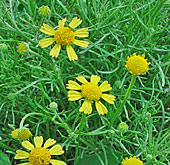
Cockscomb
This beauty will get up to two feet tall and up to two and a half feet wide. It loves full sun. Make certain to check the container and avoid plants that are root bound.
Coleus 'Big Blonde'
Another sun lover, this plant is very tough and has beautiful chartreuse leaves with dark stems. It will get up to 36 inches in height and up to 14 inches wide.
Cosmos
The good thing about Cosmos is they continue to look good even in the worst summer conditions. They come in a variety of sizes and can grow up to 2-3 feet tall. 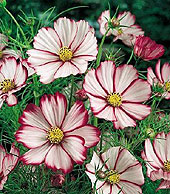 Dusty Miller This beauty makes a wonderful foliage plant. These are grown as annuals and have a decorative silver leaf.
Fanflower
This gorgeous flower blooms like crazy with flowers all along its branches. It comes in a compact form or upright and can get up to over 2 feet tall.
Gazania
This flower is available in a variety of colors and is grown as an annual in colder climates. The flower closes at night. 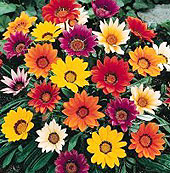
Globe Amaranth
The rounded flowers look like lollypops and it comes in a variety of colors. It can survive the heat and makes a good plant for drying. This winner can grow up to two feet tall and up to one foot wide.
Lantana
It loves the heat and doesn't need much water. It's very showy, comes in a variety of colors and blooms throughout the summer.
Mexican Sunflower
This flower can get up to six feet tall! It adores the heat and is very showy. You'll love the color all summer long.
Others include:
Helenim 'Dakota Gold'
Moss Verbena
Phlox 'Intensia'
Summer Snapdragon
Ross Moss
Sweet Potato Vine
Vinca
Texas Bluebell
Zinnia Elegans
Hopefully, this list provides you with a variety of options for plants that are easy on water, beautiful to look at, Oklahoma Proven, and are heat tolerant and sun loving.
|
=================================================
|
|
Planting A Fall Garden in Oklahoma
Each season in Oklahoma provides new opportunities and challenges for growing fresh, nutritious vegetables and fruits. Fall is often overlooked as a productive growing season, but the warm, sunny days and cooler humid nights can help produce some of the best quality garden vegetables.
Just like gardening in the spring, fall gardening preparation begins much earlier than the actual season. Factors to be considered before starting a fall garden include available garden space, crops/varieties to be grown, necessary soil preparation and obtaining quality seeds. Other important components to consider include the timing of planting and, of course, irrigation.
Some crops that were planted in the spring may continue to produce well into the fall months, especially with proper care. Tomato, pepper, okra, cow pea and New Zealand spinach often offer yields into fall. It may be necessary to prune larger plants to conserve space, but pruning also stimulates growth. Plants should be fertilized, watered and mulched at this time. As with most gardening adventures, the conditions that favor the germination of vegetables also favor grass and weeds. Insect pests may also be present in the fall months and should be monitored along with weed control.
Desirable soil will enhance the ease of production. Modification of the soil prior to and during the growing season is important for successful plant growth. Soil should absorb water easily and drain sufficiently. A porous soil is desired for vigorous root growth. Soils that produced spring crops will be easier to manage for the fall garden.
For additional information on Garden Soil Improvement, see OSU Fact Sheet HLA-6007. Another significant consideration is timing of planting. Some crops are more easily grown when seeds are planted early (with partial shade and insect protection), then transplanted into the garden at a later time. Most often, the time to plant is determined by the length of time needed to produce the crop. The time to maturation of some crops, such as radishes, can allow for successive plantings and a more continuous supply of vegetables. Broccoli, cabbage and leaf lettuce are some of the crops that respond most favorably to this method. Irish potatoes are another desirable fall crop. Fall yields are often less than spring, but the quality of the crop is excellent.
For additional information on what to plant, when to plant and how to deal with summer heat for fall vegetable gardens, go to the OSU Fact Sheet, "Fall Gardening", HLA-6009. Other Important Gardening Publications (click on the link)
Trickle Irrigation for Lawns, Gardens, and Small Orchards (BAE-1511)
Oklahoma Garden Planning Guide (HLA-6004)
Mulching Vegetable Garden Soils (HLA-6005)
Growing Tomatoes in the Home Garden (HLA-6012)
Summer Care of the Home Vegetable Garden (HLA-6013)
Vegetable Varieties for the Home Garden in Oklahoma (HLA-6032)
Common Diseases of Tomatoes, Part I: Diseases Caused by Fungi (EPP-7625)
Common Diseases of Tomatoes, Part II: Diseases Caused by Bacteria, Viruses, and Nematodes (EPP-7626)
Common Diseases of Tomatoes, Part III: Diseases Not Caused by Pathogens (EPP-7627)
Solar Heating: Solarization of Soil in Garden Plots for Control of Soil-Borne Plant Diseases (EPP-7640)
|
=================================================
|
|
Garden Math: Division & Multiplication Dividing Perennials
By definition, a perennial is any plant that lives and flowers for more than two years. Dividing perennials that grow in clumps or with bulbs and tubers can have several beneficial results:
- Increased bloom
- Increased vigor
- Eases crowding of plant
- Extras to replant elsewhere or give away
When To Divide
The rule of thumb is to divide and replant spring blooming perennials in fall, early enough that the root system has time to develop before the ground freezes. August is a great time for most divisions. Fall blooming plants can be divided in early spring as shoots begin to appear. Summer blooming perennials, such as daylilies, can be divided either in spring or fall.
Perennials live a long time and often form clumps or spread. This makes it easy and economical to start new plants from existing plants. Many perennials benefit from division every 3-4 years, especially if the plant has outgrown its space, or to expand a planting. In fact, most bloom best after division, as this encourages vigorous new growth and shoots.
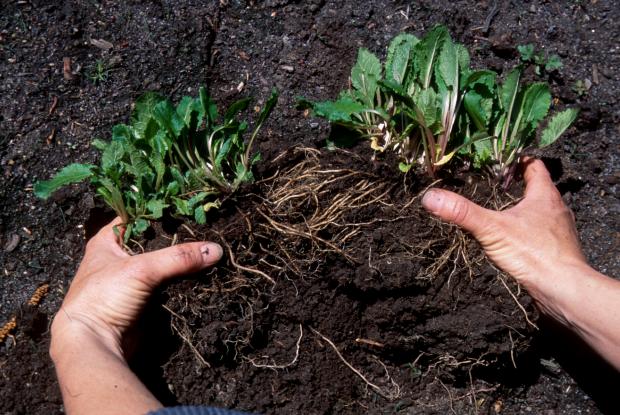 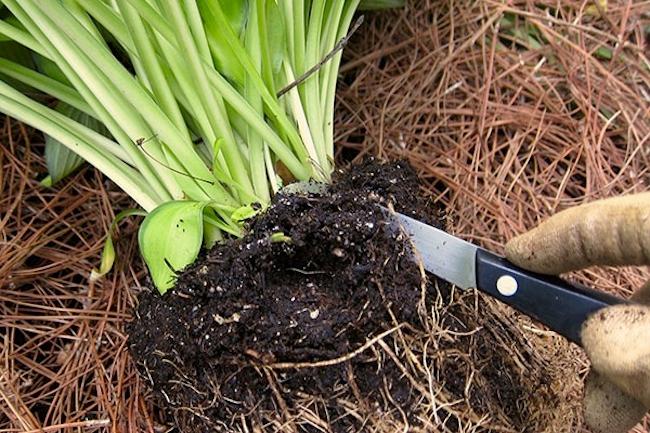
Clumping perennials generally grow larger by sending out new shoots that arise from the base of the original. Some examples are phlox, daisies, daylilies, arum, hostas, mums and many others. They eventually form a clump of multiple shoots or plantlets with a tangled mass of roots which is not easy to separate. If you can't pull them apart easily, then use a sharp knife to cut them apart. As long as the plantlets have their healthy shoots and intact roots, they will readily reproduce. When you are dividing plants, it is an opportune time to improve the soil with compost, well-rotted manure or other organic fertilizer.
How to divide rhizomes (iris, cannas), bulbs (lilies) and tubers
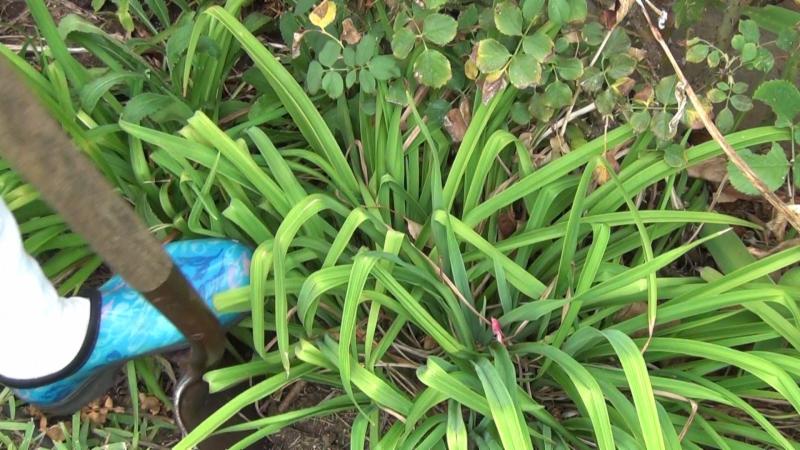 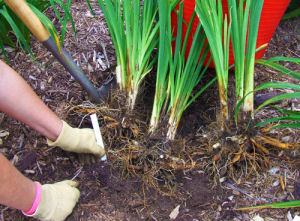
Carefully dig up the whole root system as much as possible out of the soil and try to pull it or tease it apart with your hands. If this does not work, use a sharp butcher knife or a serrated bread knife to separate, leaving at least 3 sprouting nodes (eyes) per piece.
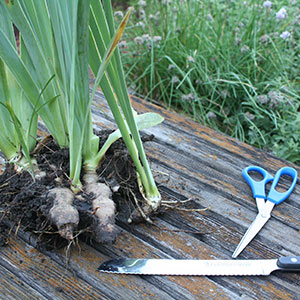
Cannas
Cannas can be divided later in the fall after the first frost. Since they may not be reliably hardy in our area, they can be lifted and stored in an area above freezing temperatures. Or, if you think your variety is hardier, leave it in the ground and mulch well for winter protection. Daylilies
Since daylilies are summer bloomers, they can be divided at any time, but it is best not to move them during the very hottest part of summer, especially in July and August. Ideal times for transplanting are early to mid-spring and early to mid-fall. Usually, daylilies do not bloom well if they are overcrowded or planted in shade. Also, be sure to deadhead spent blooms as well as removing the seed pod that forms after blooming. You want the plant to spend its energy into making more blooms and storing energy in the tuber for next year's bloom rather than making seeds. Replant with 2-3 crowns per division.
Irises
Bearded iris rhizomes should be planted or divided when they are dormant, particularly in July, August, and into mid-September. If the clumps become overcrowded after 3-4 years, the quality and quantity of flowers can decrease. Save large rhizomes with healthy leaves. Discard old leafless rhizomes from the clump's center. Work some compost, shredded leaves or other organic material into the soil and plant about a foot apart. Be careful not to bury the root too deeply, with only 1/2" - 1" of soil over the rhizome and let the top bake in the sun. Do not mulch irises as mulch makes a good habitat for iris borers, a caterpillar that eats into the rhizome.

Peonies
Peonies resent being transplanted, so plant them in a spot in full sun (6 or more hours per day) where they will stay. Do not divide except to increase your stock. If they need to be divided or moved, they may not flower the next year or two. Do not plant them too deeply or they won't bloom. The red eyes (sprouts) should be only 1/2" - 1" below the soil line for best flowering.
Daffodils
The best time to divide spring flowering bulbs such as daffodils is in the spring just as their foliage is dying down. Let the foliage mature and yellow naturally after bloom. Lift and divide only if the flowers are getting smaller and fewer in numbers. Don't forcibly break away any bulbs that are tightly joined to another bulb. Remove only those that come away easily and replant them within 3 weeks. Resources
Oklahoma State University Extension:
HLA-6408 - Landscape Maintenance Schedule HLA-6410 - Perennial Flowers for Specific Uses in Oklahoma
University of Arkansas Extension:
202013 - Annuals and Perennials In the Garden Q & A - Daylily In the Garden Q & A - Iris and Peonies
| |
======================================================
|
|
|
Q & A
Question: I have what I have been told is crapemyrtle scale. How do I get rid of it?
Answer:
This insect is new to our area, but is now fairly prevalent. It came to the US from Asia and first appeared in North-central Texas in 2004. It has subsequently spread northward into the Tulsa area from nursery stock and other sources of imported crapemyrtles. This is the reason one should always inspect nursery crapemyrtles for scale insect before purchase.
Like other scales, the life cycle begins with either the female scale or eggs overwintering on the crapemyrtle under loose bark. When the eggs hatch, small mobile "crawlers" are produced, which migrate on the plant and may be spread to other crapemyrtles by wind or birds. There may be 2-3 generations produced per year depending on the temperatures.
Once the female is fully developed, she mates and attaches to the stems and trunks of the crapemyrtle where she remains fixed and lays eggs for the next generation. She dies shortly thereafter, but the eggs survive under her covering until they hatch.
As the scales feed, they release a liquid, called "honeydew." This is similar to the behavior of aphids. The sugars in honeydew may support the growth of a fungus called "sooty mold." This overgrowth produces large black patches on the bark of the crapemyrtle. The mold is unsightly but is not significant in terms of the plant's health.
This pest is easy to identify because it is the only scale insect to infest crapemyrtles. The adult female is usually about 2mm long and has a distinctive gray-white felt-like covering. When one of the females is crushed, a pink blood-like fluid is released.
The current recommendations for control are both removal by hand and the use of winter dormant oils. Scrub down the trunk of the crapemyrtle with a mild solution of dishwashing soap and water using a long-handled brush to remove both the scale and sooty mold. This is very effective. Another treatment recommended is to spray the trunks of the trees with dormant oil in late winter. Winter dormant oil spray is a stronger concentration of a petroleum based oil than is used in summer. Neem oil, while very effective in other applications, will not be effective for this scale in winter.
Previously, systemic insecticides in the neonicotinoid family were recommended. These chemicals enter into the circulation of plants and kill the pest when they feed on the sap. They have been shown to be effective against crapemyrtle bark scale, but are no longer recommended. The reason for the change in policy is the concern that these insecticides enter the blossoms of crapemyrtles and would be harmful to bees and other pollinating insects.
| |
======================================================
|
|
|
Q & A
Question: Why is it so difficult to tell what is wrong with my tomato plants?
Answer:
Our most popular vegetable, the tomato, has so many disease, insect and cultural problems, it is a wonder that we get any production at all. Yet we do. We love to eat them so, when problems do arise, solutions are needed . . . now.
An authoritative educational manual of tomato disease lists 30 diseases caused by fungi and bacteria and even many more caused by viruses, nematode or environmental issues.
As a group, the fungal infections may attack the tomato roots, stems, leaves or fruit. Some may specialize in roots, while others in leaves and/or fruits. The root fungi, such as Fusarium, generally causes the whole plant to wilt and die. Often, opportunistic fungi will infect the dying plant, further confusing the issue.
Leaf fungi can produce brown, brown-yellow, black or grey spots and deposits. The leaf spots may be tiny, the size of a pencil tip, or involve all of the leaf. Stem infections can cause cankers (sunken, swollen or broken areas) or simply discoloration of all or parts of the stems. This can block the plants circulation. Often. the discoloration is seen only on the ends of a cut stem.
Likewise, tomato fruit development spans a host of appearances and may be difficult to sort out from some of the cultural fruit problems, such as blossom end rot or sun scald. These fruit fungi may cause dark spots, blanching, or outright rots.
Since the appearance of many of these diseases on tomato plants is so similar and non-specific, making it very difficult for even the experts to diagnose, a practical approach is to try to look at them as a group.
The conditions favoring and leading to these diseases are very similar and advantage may be taken of these similarities to form a generic set of recommendations to prevent and control the group rather than specific infectious organism.
One hitch in this approach is that some of the bacterial infections can look very much like the fungal ones and, even though the cultural recommendations listed below apply to bacteria as well as fungi, the chemical treatments are different.
Purchasing tomato plants with disease resistance will help prevent some, but by no means all, of these diseases. Heirloom varieties usually lack resistance to diseases.
Practice sanitation and prevention. Always clean up all disease -carrying plant debris at the end of the growing season. It is best to disinfect tools and tomato cages with 10% bleach before reusing.
If the garden size allows, rotate planting sites every 3-5 years. Avoid planting vegetables in the same family as tomatoes (potatoes, peppers and eggplant) in the rotations sites. They may be susceptible to the same diseases.
Avoid planting in cold soils. This may weaken the plants, promote disease and lead to stunting.
Avoid crowding tomato plants. Good air circulation is very important for all disease prevention.
Always water in the morning so the plants will be dry by nighttime. Most fungi grow best at night and when wet.
Many of the disease-causing organisms dwell in the soil in spite of best efforts. To prevent them from getting to the leaves, always try to prevent splashing by applying water to the root zones, not leaves. In addition one should apply a generous layer of most any kind of mulch. Mulch will prevent splashing of infectious organisms by irrigation or rain onto leaves. In addition, mulch will help with temperature and water management. Another strategy is to remove lower branches of the plants and use tomato cages to keep leaves and fruit from becoming infected from soil contact.
Remove any diseased leaves as soon as noticed. Put them in the trash as they are infectious.
Pesticide sprays (fungicides and antibacterial chemicals) are available. They are used for prevention or treatment of early stages of diseases. They will not cure any existing diseases and will usually have to be used every 7-10 days.
Examples of sprays available are:
o Chlorothalanil, a fungicide, found in Ortho Garden Disease Control
o Myclobutanil, fungicide, available as Immunox
o Copper sulfate, both fungicide and antibacterial, as sold by Bonide and others
There are other chemicals and brands available. Since most of tomato leaf diseases are fungal in origin and a lesser number are
bacterial, it may be best to rotate sprays using a fungicide and copper sulfate as per labeled instructions. This will give good coverage and help prevent development of resistance.
Additional Resources:
Visit with the Master Gardeners at the OSU Extension Office on 15th street.
| |
======================================================
|
|
|